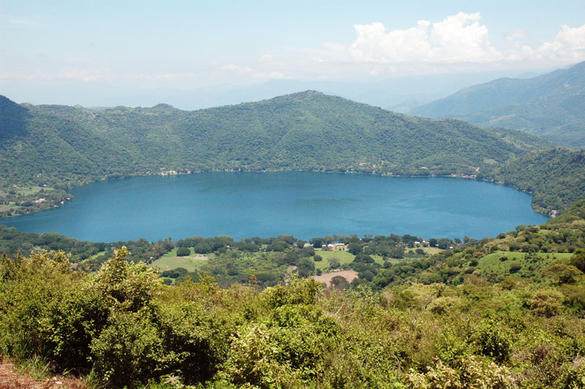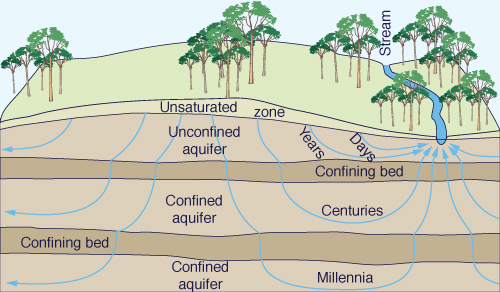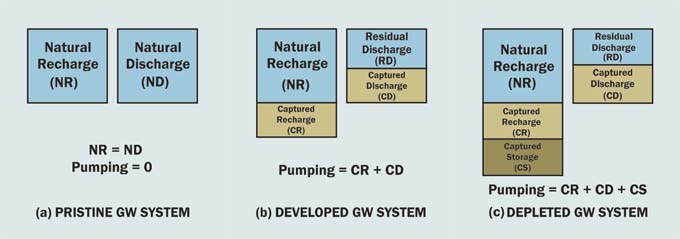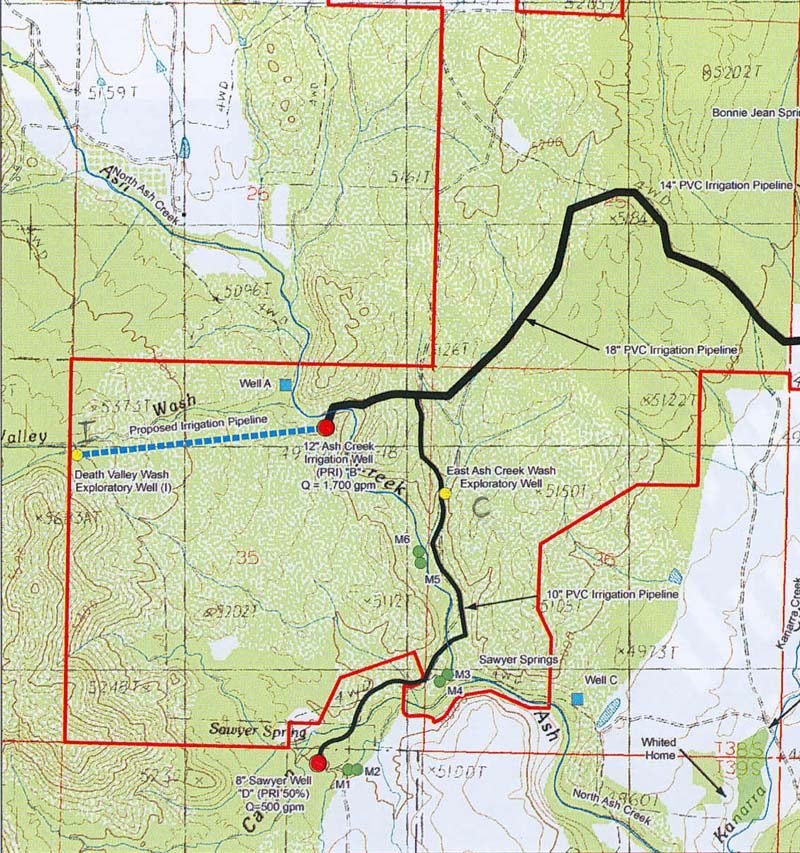1. INTRODUCTION Water is one of the most precious natural resources. It is available in two major forms; surface water and groundwater. The surface of the Earth is the facade which separates the surface water from the groundwater. Groundwater is the portion of the Earth's water cycle that flows below the Earth's surface. The geomorphology of the Earth connects the surface water and the groundwater. In many regions of the world, the pressures of economic development are producing a surface-water scarity (Ponce,2006). This has led to indiscriminate and excessive use of groundwater resources. However, this use can have diverse effects on the local hydrology and ecology. Alhough surface water and groundwater are conneted, they have very distinct properties. Surface water replenishes readily, with a global recycling time averaging 11 days (L'vovich, 1979). On the contrary, groundeater takes a long time to replenish. Recycling times for groundwater vary widely from days, to years and to centuaries depending on the properties of the aquifer. The average renewal time of grounwater is 1,400 years. Yet, expliotation of groundwatre continues till date. in a wide ranging experiment that is dominated more by econmcs and concenience than by physical reality and reason.
Surface water has been evaluated and allocated by the government. Surface water evaluation can be done because it has a control volume which is the watershed. On the contrary, groundwater resources are not allocated to anyone. Currently, anybody who can pump groundwater under his/her own properth effectively owns it. The problem arises when the excessive use of groundwater from one party affects the groundwater / surface-water of another party. The solution to this problem is the evaluation and allocation of groundwater resources. But can the groundwater be evaluated? If yes, is the procedure reliable? Is it a fact or myth? In seeking answers to the questions, we must look to the concept of control volume, safe yield of groundwater and the issue of sustainability.
2. GROUNDWATER RESOURCE EVALUATION Conventional groundwater resource evaluation is based on a water budget, with the following premise: There is this amount of recharge and, therefore, we can pump so much groundwater; thus, the focus is on the recharge. Actually, the situation is not that simple. We reckon that groundwater is not a volume, but a flow. Under natural equilibrium conditions, recharge to a control volume is coupled with a corresponding and equal discharge from the same volume. Under developed equilibrium conditions, pumping imposes an external anthropogenic demand which draws from both recharge and discharge, increasing the former and reducing the later. Under developed non-equilibrium conditions, depletion sets in, with pumping capturing an additional volume from aquifer storage. These relations are portrayed in Fig. 2. The following statements apply:
Fig. 2 Recharge and discharge in groundwater systems: (a) pristine, (b) developed, (c) depleted. The situation is clear in the case of an unconfined aquifer. Oumoing from this type of aquifer lowers the groundwater levels near the well, forming a cone of depression. The land surface overlying the the cone is known as the area of influnence of the well. Pumping changes the natural direction and the amount of groundwater flow within the area of influence. The result is more recharge to the control volume and less discharge from it. The traditional groundwater resource evaluation has sought to calculate the recharge and to limit the amount of allowable pumping to not exceed this amount. This practice has been referred to as the determination of the "safe yield." The approach, however, is flawed, because it completely disregards the existence of discharge (Sophocleous, 1997). If pursued, it will end up drying up neighboring springs and wetlands, eventually reducing baseflow in streams in the vicinity. Therefore, it is not sustainable (Alley et al., 1999) 3. CONTROL VOLUME Control volume is a volume fixed in space through which the groundwater flows. The control volume is not fixed for groundwater because it is a connected and continous system. However, in nature, groundwater is not a volume but a flow. This flow is constantly moving from a place of recharge to a place of dischrage. Disputes are bound to arise if a control volume for groundwater is fixed. This has happened in New Harmony, Utah. Sawyer Spring is a tributary of Ash Creek, near New Harmony, Utah. Water was pumped from two wells at a rate of 750 gpm and 1,700 gpm upstream of Sawyer Springs. The drawdown due to heavy discharge had eliminated surface water in Sawyer Spring. The surface water was owned by a property owner. The lowering of the water table due to pumpage also adversely affected the riperian vegetation (trees and shrubs) along the Sawyer Spring. A lawsuit was filed against the party pumping the water.
Fig. 3 Vicinity of Sawyer Spring and Ash Creek, near New Harmony, Utah (Source: LDS Church). Groundwater flows follow the prevaling gradients, which may ignore surface boundaries and therefore, defy characterization. pumping may actually change the natural direction of groundwater flow, even reversing the flow direction to adhere with the new gradients imposed by pumping. Thus matching the groundwater flow boudary with the surface water flow may be convinient, but not a correct approach always. This fact was shown by Prudic and Herman (1996) in their simulated groundwater development of Paradise Valley, in Humboldt County, Nevada. They focused on the evolving nature of capture with long-term groundwater development, and found that pumping 48% of the recharge for 300 years produced: (1) Losses in aquifer storage (2) Reduction in evapotranspiration (3) Decreased flow discharge (4) Downstream flow reversal, i.e., increases in recharge coming from the neighboring downstream basin. Table 1 shows a summary of the Prudic and Herman (1996) findings.
The size of the control volume depends of the amount of capture: The greater the capture, the larger the control volume. Thus, a purely mechanistic approach to groundwater resource evaluation is bound to be inherently flawed. The greater the amount of groundwater being captured, the larger the area of influence compromised by the pumping. Thus, as (Bredehoeft (1997) has adroitly pointed out, sustainable yield has almost nothing to do with recharge, which, at any rate, is difficult, it not impossible, to quantify. A change in focus is urgently needed. 4. WATER BUDGET MYTH Bredohoeft (2002) used a simple island aquifer surrounded by a lake to illustrate the water budget myth. Under natural condition viod of development, richarge from rainfall is balanced with the discharge to the lake. The water balance equation states:
in which Ro = natural recharge and Do = natural discharge When pumping is induced, a new water balance equation emerges as:
in which ΔRo = increased recharge induced by pumping and ΔDo = decreased discharge (positive value) due to pumping, P = abstraction rate and dV/dt = change in storage. Replacing Eq. (1) in Eq. (2) results in:
For a sustainable developemnt, The change of storage over the long-term must be zero. The new steady state water balance equation becomes:
Eq. (4) states that the sustainable pumping rate Ps is maintained by an increase of recharge and decrease of natural discharge, the sum of which is termed as capture by Lohman(1972). For the attainment of sustainable development, the pumping rate is equal to capture rate. Bredehoeft (2002) assumes that natural recharge is fixed by external factors like rainfall, vegetation and soil permeability so that the recharge in a relatively deep aquifers cannot be impacted by pumping. Under those circumstances,
From Eq. (4) and (5), it was concluded that capture has nothing to do with natural recharge. The idea that knowing the natural recharge is important in determining the size of a sustainable groundwater development is a myth. 5. SUSTAINABLE YIELD AND GROUNDWATER MANAGEMENT Abstraction of groundwater will always create a cone of depression and reduce the natural recharge. The quest for a maximun yield, with which groundwater is withdrawn without causing dangerous depletion of the groundwater storage led to the concept of safe yield. Safe yield is defined as the attainment and maintenance of a long-term balance between the amount of groundwater withdrawn annually and the annaul amount of recharge. (Sophocleus, 2001) calls safe yield unsustainable and not scienfically credible because safe yield ignores discharge from the system. Under equilibrium conditions, discharge is balanced by recharge. Consequently, if pumping equals recharge, eventually streams, marshes and springs dry up. He said that this has happened in various locations across the Great Plains. He reckons that it is irrelevant to use natural recharge in the groundwater policy to balance grounwater use. Sustainable yield does not depend on the size, depth, or hydrogeologic characteristics of the aquifer. It is now abundantly clear that sustainable yield does not depend on the aquifer's natural recharge, because the natural recharge has already been appropriated by the natural discharge (Sophocleous, 2000). Instead, sustainable yield is seen to depend on the amount of capture, and whether this capture is socially acceptable as a reasonable compromise between little or no use, on one extreme, and the sequestration of all natural discharge, on the other extreme. Sustainable yield is to be determined only after a judicious study and appraisal of all issues regarding groundwater utilization. In addition to hydrogeology, these include hydrology, ecohydrology, socioeconomics, and the related institutional and legal aspects, to name the most relevant (Ponce, 2006b). In practice, sustainable yield may be expressed as a percentage of recharge, even though there is no relation between them. If recharge is expressed as a fraction of precipitation, then sustainable yield could also be expressed as a percentage of precipitation. Holistic studies are needed to determine these percentages on a local and/or regional basis. As such, sustainable yield is seen to be a moving target, subject to change as more information leads to more knowledge, and societal perceptions change accordingly (Maimone, 2004). 6. SUMMARY The question of how much groundwater can be pumped for a particular application still remains. There are two possible approaches: 1. Pumping should be limited to the exetent that it has negative effects on the users (both natural and anthropogenic). The decision about quantifyng the degree of impact would have to be taken by a suitable institutional authority. 2. On a watershed scale, pumping is to be limited to an appropriate percentage of precipitation or recharge, this number to be determined by holistic studies and to be revised periodically as more information becomes available.
References
Maimone, M. (2004). Defining and managing sustainable yield.
Ground Water, Vol. 42, No.6, November-December, 809-814.
Ponce, V. M. (1989). Engineering Hydrology: Principles and Practices. Prentice Hall, Englewood Cliffs, New Jersey.
Ponce, V. M. (2006). Groundwater utilization and sustainability. http://groundwater.sdsu.edu
Sophocleous, M. (1997). Managing water resources systems: Why "safe yield" is not sustainable.
Ground Water, Vol. 35, No.4, July-August, 561.
Yangxiao Zhow (2009). A critical review of groundwater budget myth, safe yield and sustainability. Journal of Hydrology, Volume 370, 207-213.
| ||||||||||||||||||||||||||||||||||||||||||||||||||||||||||||||
| 151209 13:30 |



